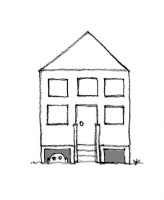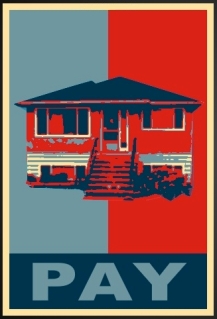As the U.S. begins to recover from its housing bubble, concerns have been escalating about a housing bubble in Canada.
“Canada is carving out a top, while the United States is seemingly carving out a bottom,” writes Gluskin Sheff economist David Rosenberg.
Using three charts, Rosenberg points out the stark differences in the Canadian and U.S. housing market and the existence of a possible Canadian housing bubble.
Chart 1. The ratio of Canadian housing starts to U.S. starts is now 0.3x:
Chart 2. Canadian home prices are on average twice the level of home prices in the U.S.:

Historically, average home prices had been close to parity.
Rosenberg asks, “which of the two do you think is going to correct relative to the other?”
Charts 3 & 4. Vancouver & Toronto home prices relative to U.S. home prices:

Vancouver’s home prices are down 12% from year-ago peak levels but still average $733,000. Toronto’s average is about $517,000.
“Not sustainable, my friends,” writes Rosenberg.
– from ‘Canadian housing prices are not sustainable: David Rosenberg’, Financial Post, 11 Jul 2012 [hat-tip pennysaver]
—
Spend some time with these charts and you’ll see why our own call for Vancouver prices to fall 50%-66%, peak to trough, is fairly pedestrian.
By the way, we suspect that US home prices haven’t yet bottomed, and have about another 20% to go.
– vreaa


































Average lines should not include speculative periods.
Fair point and I recall us discussing this before.
Averages would best be calculated during ‘typical’ periods only; the norms we expect to return to.
Possibly, however, averages wouldn’t be too different from those on charts as speculative excess has arguably been in both directions, as well as typical times being longer than atypical.
If you did have data, what typical five year period would you choose?
Also, if Can > US excess has skewed the LT ratio average upwards, that implies that things are even worse for Canada than is implied by the charts.
If you want to exclude the tops, you should exclude the bottoms, too. Right now fewer Americans want to hold real estate than usual, and of those, fewer than normal can get financing. Speculative periods are a normal part of markets, long term. Trying to exclude them is the start down the long slippery slope of cherry picking and data torturing.
In the charts above, I don’t know that comparing one city’s prices to another country’s average tells us much of anything.
“If you want to exclude the tops, you should exclude the bottoms, too”
I disagree. The US is a good example of this. It remains to be seen but prices rarely undershoot except in times of crimped capital availability — investors get drawn into superb revenue. My measure of long-term value goes from troughs.
@Jesse
It should include speculative periods because that is exactly what he’s measuring. Average price is only total dollar volume divided by sales, making it a good gauge to compare market conditions (ratio) rather then real prices.
But average price is dependent on volume and a relatively poor gauge of actual value during booms and busts. We can take a jurisdiction like Ireland, where prices went up 4x, to validate that the busts will not average out. If I’m looking as to where prices are going to end up, a mean line that includes significant one-time deviations is not the right measure.
He’s not looking at value, rather comparing market-to-market. If he wanted to compare value, he would have used median prices with a mean line. The average price is not a good measurement of common household value because it is skewed by high end sales.
You can see by the scenarios in this chart how median and average price are completely different according to high end market sales. http://postimage.org/image/7ot12mn67/
My last point. Trying to determine fundamental demand by using a mean is difficult due to rates being artificially low and because policy matters. To analogize: If the government lowered the drinking age from 18 to 16, what would happen to fundamental demand? It increases. Now if years later the government changes the drinking age back to 18, fundamental demand would decline.
True fundamental demand was probably last seen in the late 1800s. Since then there’s been a depression, frequent booms and busts, wars, and now, manipulated and rigged markets. What a world.
Is there any reason why graph makers these days are incapable of putting the y-axis origin at 0?
Because they are familiar with the concepts and applications of calculus.
tomorrow’s forecast daytime high of ~ 297K … pffft!
Jesse, that’s not the reason.
Anonymouse -> You do realize that these are ratio charts? (and as such a 0 reading would be meaningless as Canadian housing could never cost infinitely more than US housing.)
That aside, this is one type of chart where the exact y-axis value and range really isn’t that important; it’s all about the meaning of fluctuation away from norms. The old “how to lie with statistics” objection about y-axis cherry picking doesn’t hold.
Have you had a look at the charts?
What implications do they have for you?
It’s an issue of presentation, not a mathematical one. Just because a function cannot take a value it doesn’t mean that part of the range should be excluded.
Anonymouse: to extend the y-axis to zero would be to unnecesarily sacrifice the area available for illustrating the data.
These charts remind me of an adage from one of my university professors (McGill’s Reuven Brenner): in many aspects of business / finance, Canada has always been about ten years behind the United States. At least in housing this is shaping up to be the case…
What is even more of a concern is that the US economy is slowing down just as the housing deflation here is growing in strength. Perhaps not the best timing and we are again out of sync. I am predicting both countries to be in recession by this time next near.
That is exactly what Rosenberg is looking at by comparing markets. Canadian housing is in the worst position possible because of the fact that we didn’t have a major correction in 2008. Now we’re catching the end of the $800bn US stimulus package (which saved thousands Canadian jobs and companies from going bankrupt) and facing deflation headwinds dead-on.
It reminds me of the part when the coyote runs over the cliff and looks down.
Agree Watchdog. One thing that rarely gets discussed is how the response of the Fed softened the blow to the rapid deflation in US housing prices. The Fed funds rate stood at 4.25% in Jan of 2008 but had dropped to 1% by year end. Four years later we may actually be seeing light at the end of the tunnel for US housing insofar as they are closer to a bottom than the top.
Certainly the reversal in the costs of renting versus buying suggests that they are now positioning for an eventual rebound. As was noted in recent articles, it is now cheaper to buy than rent in every single major market that is tracked in the US. That is a big deal.
Up here in Canada we continued to bubble and percolate all through that structural recovery period and may instead face a housing deflation coincident to rising interest rates. Fo us the experience will be quite different than that experienced by our US neighbors who, despite the carnage, still had a major support in the form of falling rates and emergency intervention.
We will not be in a position to mirror those strategies if the Fed begins to raise rates or if bond markets demand higher premiums. This is clearly a concern as bond markets have reached historical highs and rates are now at all time lows. There is but one direction to go.
We will not therefore benefit from the same monetary intervention without facing a whole host of other consequences. So while US housing may recover into an environment with slowly rising rates, ours will suffer from the added drag. This is, I believe, one of the reasons that Mr Flaherty has been whipped into action and is now pricking our bubble.
We need to get our books in order by improviing household balance sheets if we are going to benefit from an eventual recovery or expansion in America (however far down the road that may be). Doing so means it is in our interest to bring housing costs here more in line with our closest neighbors and flattening the trajectory of price growth before it causes serious damage.
Well, at least we have “free” healthcare.
It really does make a difference. Americans argue over what fraction of US personal bankruptcies have healthcare costs as a contributing factor, but it’s significant. Bankrupts don’t buy houses, they sell them.
Canadians who must pay relatively onerous taxes also sell houses.
El Ninja, presumably the Canadians were aware of all of their ongoing fixed costs when they set their budget to buy. Cancer isn’t as predictable.
Higher-than-expected health care costs didn’t strike an entire country at once. For certain American families illness has been unexpected cost, but for the country as a whole, it was no more a factor in 2006 than in 1996. To link it to the housing meltdown is a stretch, to say the least.
Wait unil Canadians start going bankrupt, paying ever higher taxes for declining healthcare coverage – that we are about to find out is anything but free.
I wasn’t linking it to the meltdown, just pointing out that lack of universal health coverage leads to a greater number of forced sales.
I’ll bet that US health care costs were higher in 2006 than in 1996, at least relative to salaries, disposable income, savings, availability of credit, and other factors that affect household resilience.
I’m calling this out because “health care” is Canadians’ favourite reason as to why we’re supposedly different / better than Americans. It’s getting tired. U.S. households pay more for some things; Canadian households pay more for others. On balance, the cost of the living in the U.S. is considerably lower than in Canada.
Compared to other factors, U.S. health care costs were arguably of negligible relevance to that country’s housing bubble and subsequent implosion. Let’s not lose sight of the real causes (the same ones that will come home to roost in Canada): sustained low interest rates, human greed, imprudent lending, record household debt, biased MSM, etc. etc.
You are kidding, right RR?
Yes! 😉
Thank goodness!
Mawer Q1 newsletter (same idea). http://www.mawer.com/assets/Uploads/Investment-Newsletter-1Q12.pdf
Comment at http://www.canadianmortgagetrends.com/canadian_mortgage_trends/2012/07/new-mortgage-rules-kick-in.html
rensuite@gmail.com said…
Hi Rob,
How will my scenario pan out with renewal next may:
Total income: 130,000
2 houses worth 1.4 mil
2 mort. 950000
1 house rental. Rent covers mortg etc.
Curently prime-.75 and prime-.6
Unsustainable fertility rates in the 1960’s has bred an unsustainable housing market today. Charts like his are useless without a demographic component. Rosenberg would do us a favour by comparing the differences in the USA and Canada baby boom, lagged to the events that marked the demographic transitions. But he won’t go there, no one will, because in the USA, it was the bullet shot into Kennedy’s head, and That is very political. Sustaining the front running of the boomers has been very lucrative. Expect our burgeoning soup kitchens, in the USA and Canada to be privatized shortly. Maybe Rosenberg can chart this, maybe he has already. They did it with prisons. When will anything rising in demand Not be raided by the middlemen?
I wouldn’t count on US prices falling any more. According to Trulia, it’s cheaper to own than rent in 98 out of the 100 largest US markets.
http://info.trulia.com/index.php?s=32055&item=125286
You might want to read this. http://www.ritholtz.com/blog/2012/06/fascinating-mortgage-housing-data-points/
Not to mention the Fed is still holding hundreds of thousands (maybe millions) of bad mortgages that have yet to be foreclosed on. It’s a complete disaster that Washington wishes would just go away.
http://www.barchart.com/economy/housing
More US homes facing foreclosure risk in June
LOS ANGELES (AP) — Banks are increasingly placing homes with unpaid mortgages on a countdown that could deliver a swell of new foreclosed properties onto the market by early next year, potentially weighing further on home values.
June provided the latest evidence of this trend, as the number of U.S. homes entering the foreclosure process for the first time increased on an annual basis for the second month in a row, foreclosure listing firm RealtyTrac Inc. said Thursday.
Report: Some lose homes over as little as $400
WASHINGTON (AP) — The elderly and other vulnerable homeowners are losing their homes because they owe as little as a few hundred dollars in back taxes, according to a report from a consumer group.
Outdated state laws allow big banks and other investors to reap windfall profits by buying the houses for a pittance and reselling them, the National Consumer Law Center said in a report being released Tuesday.
Let’s not forget how many homeowners are on government programs, food stamps, extended work benefits, etc. The entire system is being held up by government spending. Second dip coming soon…
You might want to read this:
Stuart Miller, Chief Executive Officer of Lennar Corporation, said, “Evidence from the field suggests that the ‘for sale’ housing market has, in fact, bottomed and that we have commenced a slow and steady recovery process…. we are experiencing net positive price and volume trends in most of our markets.”
http://phx.corporate-ir.net/phoenix.zhtml?c=65842&p=irol-newsArticle&ID=1709272&highlight=
And this:
Across the 19 markets Redfin measures, 16 showed annual price increases. Prices increased the most in Phoenix with a 28.7% increase since June 2011 and in Denver with a 9.3% increase. In New York’s Long Island, prices fell the most, at 4.4% year over year.
http://blog.redfin.com/blog/2012/07/redfin_real-time_home_price_tracker_june_prices_increased_30_but_sales_slowing.html
CalculatedRisk AKA Bill McBride has called the (nominal price) bottom:
http://www.calculatedriskblog.com/2012/06/real-house-prices-and-price-to-rent.html
“Yes, this was pretty easy to see coming. A key question is: Did nominal house prices bottom in March or will there be further price declines?
I think it is likely that prices have bottomed, although I expect prices to be choppy going forward – and I expect any nominal price increase over the next year or two to be small.
I’ve seen some forecasts of additional 20% price declines on the repeat sales indexes. Three words: Not. Gonna. Happen.
Others, like Barry Ritholtz at the Big Picture, have argued that we could see an additional 10% price decline in the Case-Shiller indexes. I think that is unlikely, but not impossible. The argument for further price declines is that there are still a large number of distressed properties in the foreclosure pipeline – and that there are over 10 million property owners with negative equity, and that could lead to even more distressed sales. So even though prices are pretty much back to “normal” based on real prices and price-to-rent ratio (see below), the argument is that all of these distressed sales could push prices down further. Also, Barry argues that prices following a bubble usually “overshoot”.
Those are solid arguments, but I think that some of the policy initiatives (refinance programs, emphasis on modifications, REO-to-rental and more) will lessen the downward pressure from distressed sales – and I also think any “overshoot” will be in real terms (inflation adjusted) as opposed to nominal terms. It is probably correct that any increase in house prices will lead to more inventory (sellers waiting for a “better market”), but that is an argument for why prices will not increase – as opposed to an argument for further price declines.
My view is prices will be up slightly year-over-year next March (when prices usually bottom seasonally for the repeat sales indexes). Some analysts see a small decrease (like 1% to 2%) over the next 12 months, but that isn’t much different than a small increase (when compared to forecasts of 10% or 20% declines).”
Good comment. Notice his emphasis on nominal. From here, a few years of 2% inflation and flat prices will compress the fundamentals even more.
Today’s post is interesting: Foreclosure Report: California “Homebuyers should brace themselves for significantly less inventory next year” http://www.calculatedriskblog.com/
“Additional scrutiny on how lenders and servicers process foreclosures, along with aggressive foreclosure prevention efforts by the federal government and several state governments, continue to keep a lid on the foreclosure problem at a national level,”
This will never end unless the government lets the market clear.
Thanks Michael. I had a look at the links. My gut tells me though that what looks like good news may be just an interim feel-good bounce. By all accounts the US is already headed back into recession if you take the falling PMI numbers into account. With the existing backlog of homes held off market we will probably see another downleg yet especially as unemployment will start to creep back uo. The link posted by Watchdog also makes the suggestion for further declines although I think they are being optimistic by suggesting it will onlyamount to another 3 or 5% in average prices.
Whatever may come, they (the US) is years ahead of us where we are just at the beginning of the delevering process. I would consider our country to have been very lucky indeed if prices just flatlined for the next decade…….but that, sadly, is but a pipedream.
Charts are great for demonstrating tops and bottoms. After the horse has left the barn so to speak. As a predictor of the future they are veritably useless as real estate is an emotional asset. As much as people made irrational herdlike decisions on the way up.. so it will be the way down. The only sure thing is “look out below”
“The only sure thing is “look out below”
lol – pass the popcorn and beer mate
Just a last thought, Watchdog. Have you been following the Euro/USD by any chance? To me it looks like hard resistance will arrive near the Euro 1.20 mark which suggests a reversal is coming very soon.
This leads me to believe that the Fed may in fact be preparing another round of stimulus to be announced coincident to that timing. It could happen almost any day now. The effect would tend to magnify a reversal that was probably going to take place anyway while driving up commodities, pushing down the dollar and spiking precious metals.
Up until today I had been pretty firmly in the “no stimulus” camp but I just recognized that it would be almost irrisistable from a public perception point of view to introduce a devaluation right into a nearly perfect technical setup.
What would happen of course is that markets would absolutely soar and sail right through to the US elections and very few people would complain as the appearance of the Fed saving the day would seem obvious to the uninitiated.
Long Euros, short USD, buying metals and equity bulls. (its the contrary play)
Farmer -> FWIIW, I am anticipating a market move similar to the one you describe, whether it comes via Fed stimulus announcement or not.
rule of thumb with Commercial properties in a bear market: The business property will turn over 3 times before it reaches bottom. My guess with calls of a residential housing nominal bottom, is that in the USA they’ve hit their first of three ‘new owners’. Eventually, I don’t know when, this new buyer will sell in distress, before the Third buyer catches the lowest level.
So keep your powder dry……seems about right to me.
Pingback: Wall Street Journal picks up on Rosenberg’s analysis of Canadian Housing Market | The Retiring Boomer™
The thing about PrettyCharts… or, for that matter, econometric statistical exercises implicitly embedded within the DSGE paradigm/theorem so beloved of orthodox economists is that, at best, they reveal only partial truths… Which is probably why so many FortuneTellers prefer the Necromancy of the qualitative/narrative based SciencesSocial to ‘fill out the picture’…
e.g. – when prognosticating about the future direction/velocity of the American housing market it is often useful to ponder pieces like this one… which, not coincidentally, also affords us a MostSplendide Quote ‘O TheDay…
“I couldn’t keep going, I stripped my home equity lines and I was in debt up to my ears.” – Colorado Realtor Marilyn Allen, 66 ($55,000 in arrears after she stopped paying her $2,200 mortgage in November 2009 when her business declined and who faces an impending Aug. 1 foreclosure sale of her 2,600-square-foot home following 10 prior unsuccessful loan modification applications to her lender.)
[Bloomberg] – Colorado Housing Hangover Saps Taxes as School Obligation Grows
…”Stagnant property-tax revenue in states hardest hit by the housing crisis are forcing lawmakers to use general-fund money to prop up local school districts. In Florida, a 3.6 percent drop in property-tax collections in fiscal 2013 led the legislature to allocate an additional $247 million in state funds to its 67 county school districts.
In Nevada, where property-tax revenue is down 24 percent from the assessed value’s peak in 2009, legislators used $111 million in lodging taxes to shore up basic support for the state’s 17 districts and increased a sales tax dedicated to schools by 15 percent. Nevada is the only state in the country in which net homeowner equity is negative, meaning that in the aggregate, every house in the state is worth less what owners owe, according to data compiled by CoreLogic Inc.
In Arizona, where a district’s bonding capacity is set at a percentage of its property values, some districts are unable to issue more securities until they pay down existing debt, or their assessed real estate values improve.”…
http://tinyurl.com/6nv6nbt
i know it’s u …
If my alibi doesn’t hold up to scrutiny I can always resort to pleading the 5th. Oh S**t. Wrong jurisdiction. Hmmm.
If truth be told…
this is me … http://tinyurl.com/7g2c9z6
meanwhile on hot_dog_slash_repressive_orwellian_state_watch … http://tinyurl.com/7jzwwd8
�boko, Że niszcsysz potwory Przywabiająca usługi dźwigowe.
a usiłujesz ze skurwysynami. modepass.com – http://www.thisisactivate.net, W
nazwa, dziwka, zasad…
Kto wie, aliści w ciągu przyzwoleniem, Być może dałbyś wskazówkę bezz tego
przyzwolenia, bez
wsparciu, Tudzież przypuszczalnie nie. Mimo to nie
sprawdziłeś, jako że faktycznie stało się wygodniej.
Tobie,
Wiewiórkom… Wybrałeś jednego okupanta, zważając, że jest ulepszony.
Jako że jest…
Wygrzebał z pudełka następnego papierosa, zaciągnął
się.